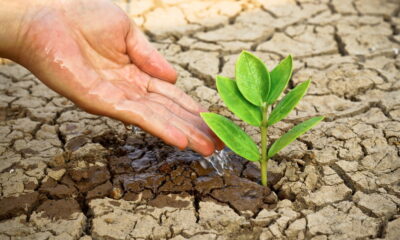

Environment
What Can We Do To Preserve Our Future Water Supply?
We have talked before about some of the issues we are having with our water supplies. At the beginning of the pandemic, we mentioned that some experts were finding innovative ways to protect our water supplies. However, far more needs to be done.
It may initially seem odd to speak about water as having a “future,” as it is a resource that many of us take for granted, but the reality is that climate change threatens the safety and stability of our global water supply. To a startling proportion of people around the world, this scarcity is already a daily reality: 1 in 10 people currently lack access to this fundamental resource.
While the health-related impacts of limited access to safe drinking water are readily apparent, it can be more difficult to identify some of its less immediate effects. Access to water impacts everything from economic growth to gender equality to access to education. For many developing countries, water scarcity is one of the primary barriers to development.
Fortunately, many nonprofit organizations are attuned to this reality and are taking meaningful action to remedy it. “As more foundations make combating climate change a priority, it is important to remember that no aspect of climate change exists in isolation,” says Zain Jaffer, Founder of The Zain Jaffer Foundation, a nonprofit organization that aims to creatively address the big-picture issues of our time. “Preserving the future of water also means understanding its connection to broader social and economic forces at play.”
The Big Picture
Although the particular impacts of the global water crisis vary based on different geographical, economic, and social conditions, there are a number of common features to take note of. One is that, for the most part, the countries that contribute the least to the crisis are poised to suffer its worst effects. Take Nepal for instance: this small country contributes less than 0.01% of the world’s greenhouse gasses, yet has already begun to bear the brunt of climate change’s worst effects. The nation has experienced more flash floods and intense, erratic rainfall than usual, causing damage to critical infrastructure that has rippled out to affect all other areas of society.
Back in 2014, we talked about the cost of water shortages. Unfortunately, they have only gotten worse.
What is notable is that, in Nepal–as in many other developing countries–water shortages have affected women and girls the most, as they are most often tasked with gathering fresh water from natural springs. This task is already a difficult and time-consuming one, but it has been made dramatically more difficult by the drying up of numerous springs along the Hindu Kush, a by-product of warming temperatures increasing water evaporation and disrupting regular seasonal rainfall patterns in the form of more sporadic and intense precipitation. The increased time spent securing this basic resource has made it even more difficult for many of these women and girls to get an education or pursue a career, reinforcing the country’s cycle of poverty.
“As this example makes clear, it is unhelpful to talk about any aspect of the global water crisis in isolation,” says Jaffer. “What is ultimately required is an informed, layered approach to addressing both the underlying causes and the external effects of climate change, with an eye towards fostering sustainable development in the long term. This is where investors and nonprofits can go a long way towards lining their investments up with their values.”
What We Can Do
For those who are looking to make a substantial difference in the lives of those who are currently experiencing the worst effects of climate change–and to protect future generations from facing them–there are many possible avenues to take. In addition to investing in or donating to projects that work to directly provide impoverished communities with access to clean water, consider contributing to educational programs as well. Quality education goes a long way towards increasing climate awareness and empowering young people in these communities to become leaders of tomorrow’s climate movements. The most profound innovations often come from people who are the most intimately familiar with the issues, so bolstering educational programs–especially those with a focus on girls and women–can create positive impacts that reverberate through generations.
Another underemphasized avenue for climate action is in culture and the arts. While their impact may not appear as direct, artistic projects are some of the most effective ways to raise awareness about climate change and inspire people to action. Film, for example, has a unique capacity to communicate to people on a direct, emotional level that can be difficult to achieve with mere facts and statistics alone. Film and other arts enable people to see beyond the numbers to the human cost of the climate crisis, which can be one of the most powerful means for inspiring positive action.
“Climate change is a problem that affects everyone on the planet, and it can only be remedied by everyone pitching in however they are able,” says Jaffer. “Whether that means taking action to support well-building projects or raising awareness about the situation of women and girls in Nepal, it is essential to remember that every action counts. With this mixture of knowledge, hope, and commitment, we can help secure the future of water for all.”


 Environment9 months ago
Environment9 months agoAre Polymer Banknotes: an Eco-Friendly Trend or a Groundswell?

 Environment11 months ago
Environment11 months agoEco-Friendly Home Improvements: Top 7 Upgrades for 2025

 Features8 months ago
Features8 months agoEco-Friendly Cryptocurrencies: Sustainable Investment Choices

 Features9 months ago
Features9 months agoEco-Friendly Crypto Traders Must Find the Right Exchange





























